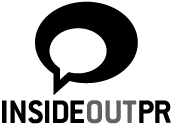The Speakers Practice has invited Australian Business owners to submit articles on the topic of the Presentation Skills in the workplace. Contributors are experts in their industry , discussing aspects and giving advice concerning presentation skills in their field of expertise.Introducing InsideOut PR –
INSIDEOUTPR specialises in internal and external communications for corporate and consumer brands. Break-through media coverage, strong brand engagement, a social media following, and messaging that resonates with your target audience.
In most realms of PR, marketing and advertising, being able to effectively communicate your ideas is essential. However not all of us are blessed with the coveted “confidence” gene…so we gotta fake it, til’ we make it!
To help get you over the line, we have come up with some simple tips that will have your audience sitting on the edge of their seats.
Be Prepared – Know your product inside and out and predict the types of questions that may come up in your presentation, so that you can answer them without fumbling. Make a list of the main points you want to convey and memorise, so that if you find yourself talking off track during the speech, you can always find your way back.
Engage – To engage with your audience, you must know them. Immerse yourself in their culture, use their jargon and make references they can relate to. Most importantly, try and make them feel a part of the speech. This can be done by using interactive phrases, such as “we are about to witness a revolution” and “I don’t know if you have this problem, but…”
Laugh – Don’t be afraid to throw in a few one liners. The trick is to keep them witty and inoffensive. Laughter helps keep your audience alert and makes you (the presenter) more likeable. Remember, if you have to question whether a joke will work with your audience, don’t risk it.
Loosen Up – One of the biggest mistakes presenters make is to stand still. It doesn’t look natural and is a dead giveaway that you are uncomfortable. Try and pretend you are conversing with friends, use hand-gestures, take a couple of steps around and try to take a relaxed stance. The easiest way to do this is to unlock the knee joints, keep your chest and chin out and your shoulders back.
Watch Yourself – When nervous, most people overuse stalling words like ‘um’ or ‘ah’ without even noticing. This can get irritating for an audience, and can lead them to lose. The best way to avoid using these words is to first identify your fall-back word (the word that you are most likely to fall back on when stalling). Practice in front of a friend and get them to help you pick it and when you know what word to avoid, it makes it easier to stop yourself from saying it.
Once you have nailed these, you are ready to go and pitch your ideas to the world. If you still need a confidence booster InsideOut PR finds that donning a killer pair of heels always helps!
Thanks to the team of InsideOutsidePR – to find out more about this dynamic PR team , based at Crows Nest, see www.insideoutpr.com.au . They can assist you to promote your business.


